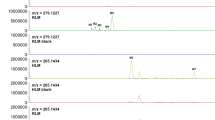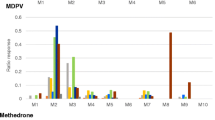Summary
Chlormezanone binds to oxidized cytochrome P450 in rat liver microsomes with a binding curve according to type I like hexobarbital but less pronounced and with a general shift to the left. Ethylmorphine N-demethylation, ethoxycoumarin and ethoxyresorufin O-deethylation are inhibited by chlormezanone in mM concentrations only whereas pentoxyreosorufin O-depentylation is inhibited by about 50% in μM concentrations. Luminol and lucigenin amplified chemiluminescence indicating the formation of reactive oxygen species was not influenced in concentration ranges between mM and μM, whereas NADPH/Fe stimulated lipid peroxidation showed a tendency of inhibition. But scavenger activity could not be demonstrated: the zymosan stimulated chemiluminescence of whole blood was not influenced significantly.
The degradation process of chlormezanone was elucidated. The first step involves ring opening by chemical hydrolysis with subsequent formation of an unstable acyhalfaminal which is the source of 4-chlorobenzaldehyde. This aldehyde undergoes enzymatically controlled oxidation to 4-chlorobenzoic acid which is the parent compound of following phase II reactions. The second degradation product is 2-carboxyethane-sulfinic-acid-N-methylamide, which is hydrolyzed very quickly. Neither oxidation of the sulfinic acid or its N-nethylamide derivative could be observed nor N-demethylation of chlormezanone.
Similar content being viewed by others
References
Oelschläger H., Lemmer B., Rothley D., Nold G., Riederer H., von Fallois J. (1995): New results on the pharmacokinetics of chlormezanone. Eur. J. Clin. Pharmacol., 49, A159.
Archakov A.I., Zhukov A.A. (1989): Multiple activities of cytochrome P450. In: Ruckpaul K., Rein H. (Eds) Basis and Mechanisms of Regulation of Cytochrome P450, Vol. 1. Berlin: Akademie-Verlag, 151–175.
Kretzschmar M., Klinger W. (1991): Ontogenetic changes in hepatic glutathione system (synthesis, catabolism, export) of male Uje: WIST rats. J. Exp. Anim. Sci., 34, 132–139.
Barth A., Bernst M. (1992): Influence of bile acids on stimulated lipid peroxidation and hydrogen production in rat liver microsomes. Exp. Toxic. Pathol., 44, 399–405.
Klinger W., Müller D. (1974): The influence of age on the protein concentration in serum liver and kidney of rats determined by various methods. Z. Versuchstierk., 16, 146–153.
Schenkman J.B., Remmer H., Estabrook R.W. (1967): Spectral studies of drug interaction with hepatic microsomal cytochrome. Mol. Pharmacol., 3, 113–123.
Klinger W., Müller D. (1977): Ethylmorphine N-demethylation by liver homogenate of newborn and adult rats; enzyme kinetics and age course of Vmax and Km. Acta Biol. Med. Germ., 36, 1149–1159.
Aitio A. (1978): A simple and sensitive assay of 7-ethoxycoumarin deethylation. Anal. Biochem., 85, 488–490.
Pohl R.J., Fouts J.R. (1980): A rapid method for assaying the metabolism of 7-ethoxyresorufin by microsomal subcellular fractions. Anal. Biochem., 107, 150–155.
Lubet R.A., Mayer R.T., Cameron J.W. (1985): A rapid and sensitive assay for measuring induction of cytochrome(s) P-450 by phenobarbital and other xenobiotics in the rat. Arch. Biochem. Biophys., 238, 43–48.
Müller-Peddinghaus R., Wurl M. (1987): The amplified chemiluminescence test to characterize antirheumatic drugs as oxygen radical scavengers. Biochem. Pharmacol., 36, 1125–1132.
Klinger W., Karge E., Kretzschmar M. et al. (1996): Luminol-and lucigenin-amplified chemiluminescence with rat liver microsomes: kinetics and influence of ascorbic acid, glutathione, dimethyl-sulfoxide, N-t-butyl-a-phenylnitrone, copper-ions and a copper complex, catalase, superoxide dismutase, hexobarbital and aniline. Exp. Toxic. Pathol., 48, 447–460.
Buege J.K.A., Aust S.D. (1978): Microsomal lipid peroxydation. Methods Enzymol., 52, 302–310.
Barth A., Bernst M. (1992): Influence of bile acids on stimulated lipid peroxidation and hydrogen peroxide production in rat liver microsomes. Exp. Toxic Pathol., 44, 399–405.
Allen R.C. (1986): Phagocytic leukocyte oxygenation activities and chemiluminescence: a kinetic approach to analysis. Methods Enzymol., 133, 449–491.
Author information
Authors and Affiliations
Rights and permissions
About this article
Cite this article
Klinger, W., Oelschläger, H., Karge, E. et al. Interaction of chlormezanone with rat liver microsomes and its degradation. European Journal of Drug Metabolism and Pharmacokinetics 22, 165–171 (1997). https://doi.org/10.1007/BF03189801
Received:
Issue Date:
DOI: https://doi.org/10.1007/BF03189801




